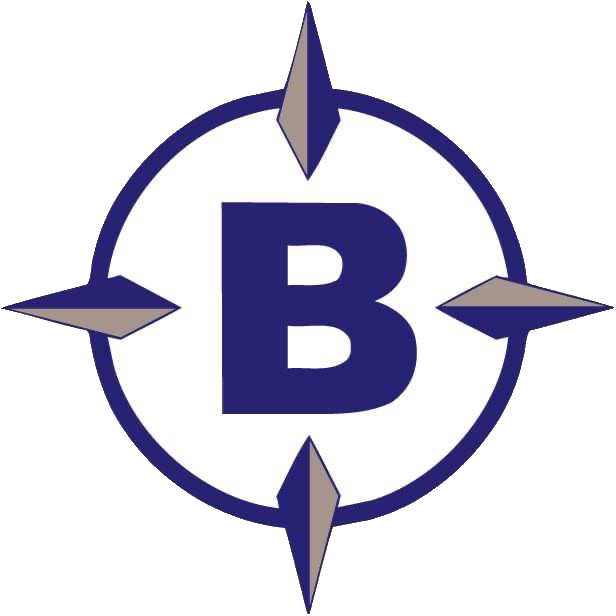top of page
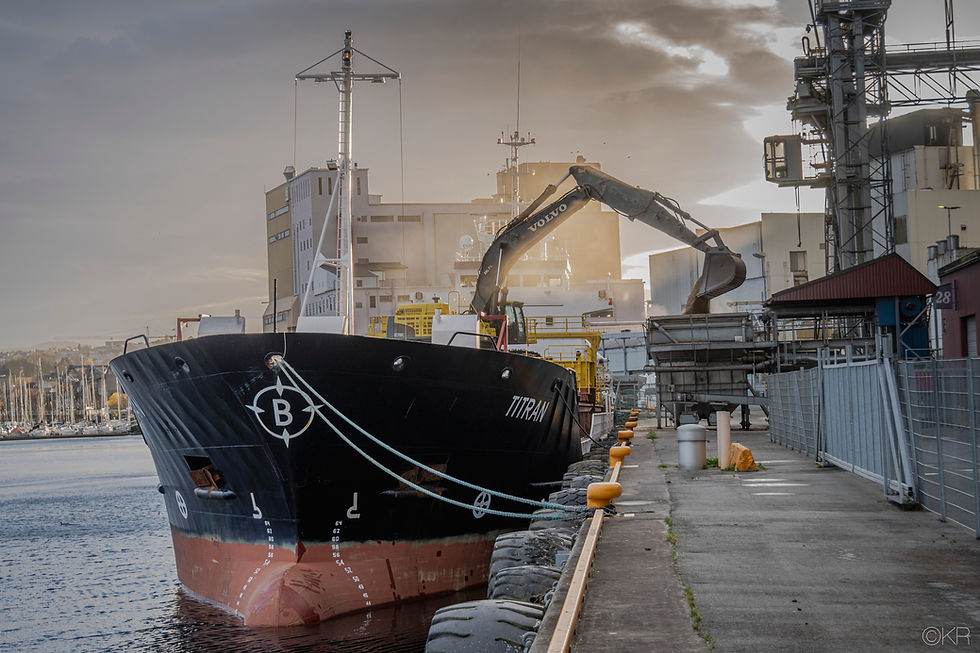
Our story at sea
Discover our History
From humble beginnings, Berge Rederi AS has grown into a family founded company built on dedication, hard work and a deep passion for the maritime life at sea. Over the years, we have proudly acquired and operated a fleet of different vessels, each playing an important role in shaping who we are today.
This page is a tribute to that journey, a showcase of every vessel that has carried our name and our values across the waters. Each ship holds a chapter of our history, reflecting the commitment and perseverance that have guided us from our early days to where we stand today.

1940
MV JAGO
MV JAGO originally named Njål II, was built in 1917 by Sigurd Witzøe on the island of Frøya. Measuring 62 feet in length, 14.6 feet in width and 7.6 feet in depth, the vessel had a Gross Register Tonnage (GRT) of 24 and was powered by a 25 HP Wickmann engine. The original owner retained possession until 1938 and in 1940 ownership transferred to Kristian Gabrielsen, who was Anne Gunn's grandfather and Sigurd's half-brother. Subsequently, Anne Gunn's father assumed ownership of the vessel.
In 1951, the vessel underwent a significant rebuild and was rechristened JAGO, retaining its original registration number. The name JAGO was derived from the first names of Anne Gunn's father and aunts: Jørgen, Anna, Gerda and Oddbjørg. The vessel was registered for sea and coastal fishing. After many years of dedicated service, JAGO was sold to Egersund in 1965.
Anne Gunn reacquired JAGO in 2016 with the intention of restoring the historic vessel. Unfortunately during a severe storm, JAGO sank at the quay and had to be sent for scrapping after more than a century of service. Despite her eventual fate, JAGO was a vessel of great historical significance, well maintained throughout her long life and had a limited number of owners.

1948
MV Selvaagsund
The first MV Selvaagsund was a cargo vessel owned by Magne and Øivind Berge's grandfather. Acquired in 1948 and sold in 1976, the vessel primarily shipped timber to northern Norway and fish on the return journey southbound. In her later years, Selvaagsund operated around the areas of Hitra and Frøya. The name "Selvaagsund" is derived from two places where Øivind Berge resided: Selvågen and Knarrlagsund. Both locations are situated on the island of Ulvøya, approximately 1 kilometer apart.
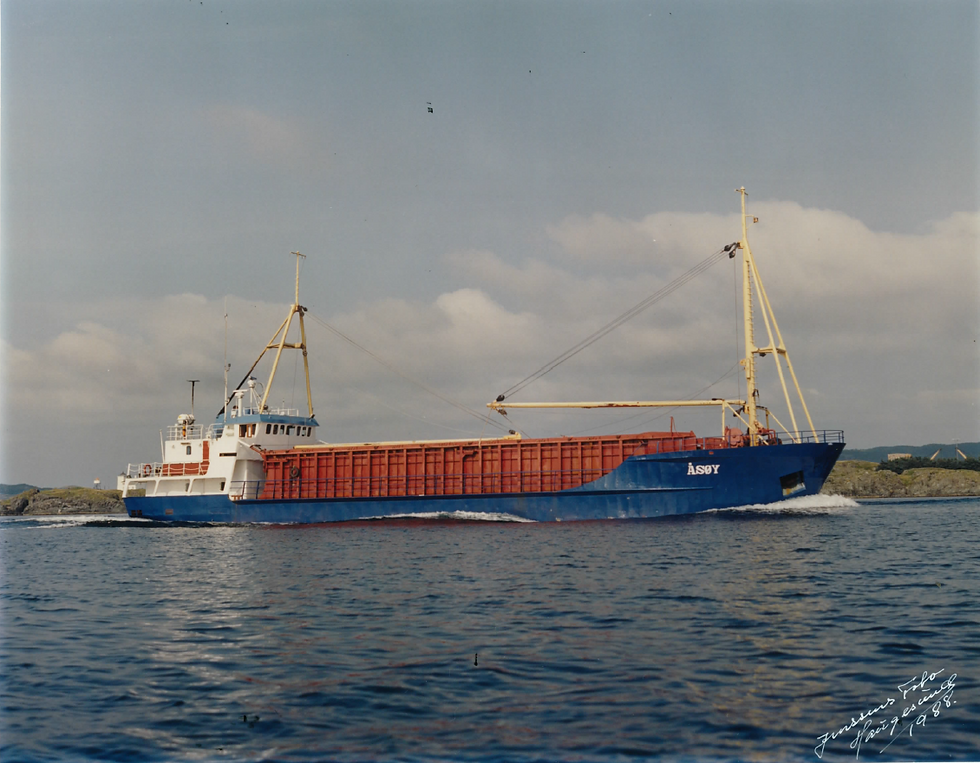
1987
MV Åsøy
MV Åsøy was a vessel owned by Oddvar Berge AS. Oddvar Berge, the father of Magne and Øivind Berge, named the vessel after their mother, Åse. Magne and Øivind Berge began their maritime careers onboard Åsøy, which fostered their burgeoning interest in cargo vessels. The vessel had a deadweight tonnage of 550 and measured 41 meters in length. She was engaged in shipments consisting of timber and general cargo along the Norwegian coast. The chartering broker for the vessel was Selboe Shipping AS. At that time, Kjetil Rimolsrønning now the owner of Rimship AS, was employed by Selboe Shipping AS.
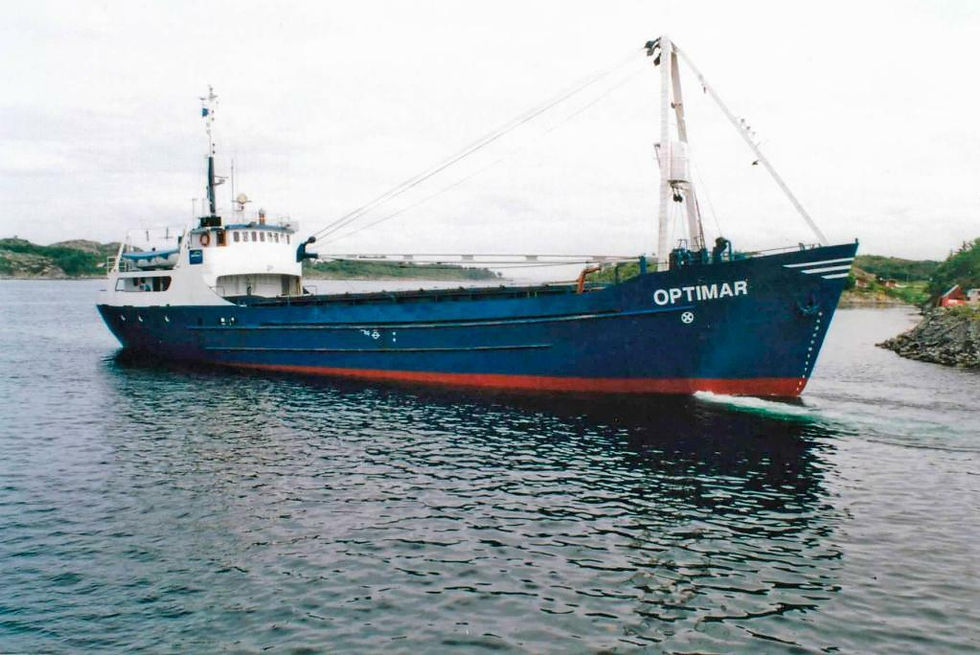
1997
MV OptiMar
Berge Rederi AS, originally established as Magne Berge Fraktebåtrederi AS, was founded in 1997. During the same year, the company acquired MV Nordvik and subsequently renamed the vessel MV OptiMar. The name OptiMar was chosen by the charterer BioMar AS, reflecting their fish food product, OptiMal. The vessel measured 45 meters in length, had a maximum capacity to load 360 metric tons of fish fodder. OptiMar was chartered by BioMar AS and was loaded bi-weekly at their factory on Karmøy. The vessel's weekly schedule included one voyage to Austevoll/Bergen and another voyage to the areas around Hitra/Frøya. The acquisition of MV OptiMar marked a significant milestone as the beginning of Berge Rederi AS. Ultimately, OptiMar was sold to Geir Mørk Sjøtransport AS in Tromsø in 1999.
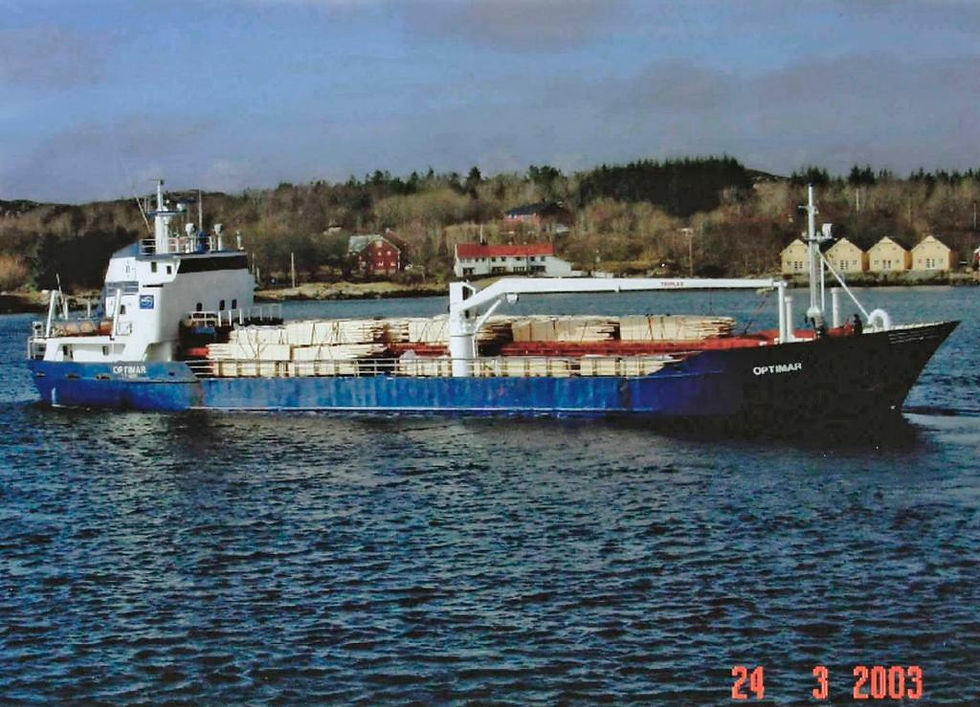
1999
MV DanaNor
The vessel MV Eva Merethe was acquired in 1999. This vessel, with a deadweight tonnage of 800 and a length of 54 meters, had a maximum loading capacity of 650 metric tons of fish feed. Upon acquisition, she was renamed to the familiar name MV OptiMar after the original vessel was sold, also in 1999. The second OptiMar continued operating along the same trade routes as her predecessor until she was renamed MV DanaNor in 2003. The new name, DanaNor was chosen by the vessel's charterer, DanaFeed. Concurrently, the trade area was revised to encompass Denmark and Norway for the shipping of fish feed. In 2007, DanaNor was sold to a shipping company in Greece.

2000
MV Sletringen
In the year 2000, the vessel MV Mina Mare was acquired from Spanish owners and subsequently renamed MV Sletringen. The name Sletringen was inspired by the lighthouse named Sletringen near Titran, where Anne Gunn and Magne resided at that time. The vessel had a deadweight tonnage of 2889 deadweight tonnage, measured 63 meters in length and was the first vessel equipped with an excavator. Furthermore, a second company named Sletringen Bulk AS, was founded prior to the acquisition to hold ownership over the vessel. The ownership of the company itself was distributed among Magne, Anne Gunn, Oddvar and Øivind Berge, Frøyfisk AS, and Tor Arnar Skeie. The acquisition of the first Sletringen marked the inception of Berge Rederi's current bulk cargo operations. Ultimately, Sletringen was sold to a Croatian company in 2005.

2004
MV JAGO
In November 2004, Ulvan/Berge Rederi AS acquired the livestock carrier MV Holstein Express and subsequently converted her into a general cargo carrier, renaming her MV Frohavet. By April 2006, Sletringen Bulk AS acquired Frohavet from Ulvan/Berge Rederi AS and once again renamed her to MV JAGO, like the vessel formerly owned by Anne Gunn’s family decades ago. The second JAGO was then modified to ship fish feed from Denmark to Norway, assuming the route previously performed by MV DanaNor. The primary cargo on northbound journeys included fish feed and general cargo. Additionally, the vessel was outfitted with specialized equipment to discharge fish feed directly into silos on barges. On southbound voyages, the main cargo comprised of fertilizer, chalk, dolomite in big bags, herring in barrels and small boats. In December 2008, the second JAGO was sold to Bio Feeder AS and subsequently renamed MV Kryssholm. The vessel continued to transport fish feed until she was decommissioned and scrapped in February 2017.

2006
MV Sletringen
In January 2006, Sletringen Bulk AS acquired the vessel MV Vega from Veninga & Zn CV and subsequently renamed her MV Sletringen like her predecessor sold in 2005. Later that year, Sletringen underwent a significant transformation into a self-discharger in Tallinn. The vessel's cargo capacity was 2 350 metric tons, with a cargo hold volume of 3 226 cubic meters, which included two movable bulkheads. The second Sletringen proved to be a valuable asset and a crucial source of revenue for the company. The primary cargo consisted of raw materials for the salmon and agriculture industries in Norway, with outbound shipments mainly comprising dolomite and split stones. In March 2019, Sletringen was sold to Russian Sea-Aquaculture LLC and received a new name, Valeri Kharlamov.
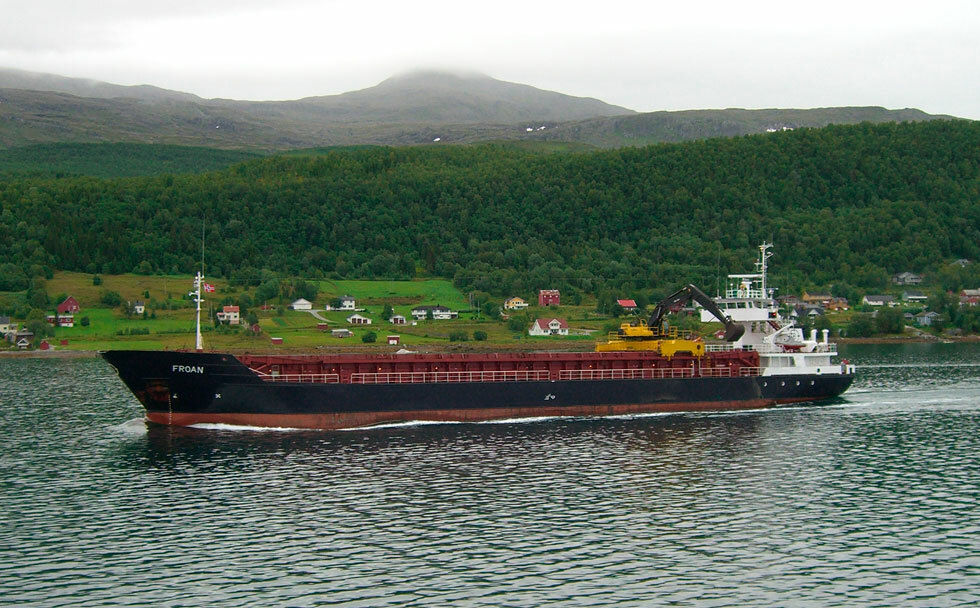
2007
MV Froan
On March 26. 2007, Sletringen Bulk AS and Berge Rederi AS merged into a single company. The ownership structure was adjusted to its current configuration, comprising of Knarrlagsund Holding AS, Øivind Berge Holding AS and Frøya Skipsinvest AS. In the same year, Berge Rederi AS acquired the vessel MV Wachau from Oesterreicher Lloyd Ship Management Gmbh and subsequently renamed her MV Froan. The name Froan was derived from the archipelago situated off the island of Frøya. Additionally, in 2007, the vessel like the second MV Sletringen underwent modifications in Tallinn to become a self-discharger. The cargo capacity of Froan was 3 500 metric tons, with a cargo hold of 4 650 cubic meters and equipped with two movable bulkheads.
Similar to the second Sletringen, Froan began her service years as a highly valuable asset for the company. Even during the financial crisis of 2008, she continued to generate a respectable income. The vessel's primary cargo consisted of raw materials for the salmon and agriculture industries in Norway, with outbound cargoes primarily comprising of dolomite and split stones. In September 2022, Froan was sold to a Greek company and renamed MV Taxiarchis Michail.

2007
MV Selvaagsund
In December 2007, Berge Rederi AS acquired the vessel MV Aurora from Wagenborg BV and subsequently renamed her MV Selvaagsund. At the beginning of 2008, the second Selvaagsund underwent modifications in Tallinn to become a self-discharging vessel. The vessel boasted a cargo capacity of 2 350 metric tons and a cargo hold volume of 3 226 cubic meters, featuring two movable bulkheads. Primarily, the second Selvaagsund shipped raw materials for the salmon and agriculture industries in Norway, with outbound cargoes consisting mainly of dolomite and split stones. In March 2021, Selvaagsund was sold to Russian Sea-Aquaculture LLC and renamed MV Aleksander Gusev.
Similar to the second Sletringen, Froan began her service years as a highly valuable asset for the company. Even during the financial crisis of 2008, she continued to generate a respectable income. The vessel's primary cargo consisted of raw materials for the salmon and agriculture industries in Norway, with outbound cargoes primarily comprising of dolomite and split stones. In September 2022, Froan was sold to a Greek company and renamed MV Taxiarchis Michail.

2009
MV JAGO
In January 2009, Berge Rederi AS acquired the vessel MV Falknes from "Ingvar Falkeid og sønner" and subsequently renamed her MV JAGO like her predecessor sold in 2008. At the time of purchase, the vessel was already equipped with self-discharging capabilities. She boasted a cargo capacity of 2 000 metric tons and a cargo hold measuring 2 888 cubic meters, featuring two movable bulkheads. Initially, the third JAGO was intended to take over the general cargo trade from the previous JAGO, combining this with bulk cargo. However, this plan was later revised to focus solely on bulk cargoes, primarily shipping raw materials for the agriculture industry in Norway. When no other cargo was available, she shipped split stones.
In March 2017, the third JAGO was chartered on a Bareboat Charter Party (BBCP) to Helco II AS (Bergen Shipping AS) and was renamed MV Havbris. At the conclusion of the BBCP in February 2022, Helco II AS purchased the vessel.Similar to the second Sletringen, Froan began her service years as a highly valuable asset for the company. Even during the financial crisis of 2008, she continued to generate a respectable income. The vessel's primary cargo consisted of raw materials for the salmon and agriculture industries in Norway, with outbound cargoes primarily comprising of dolomite and split stones. In September 2022, Froan was sold to a Greek company and renamed MV Taxiarchis Michail.

2010
MV Titran
In January 2010, Berge Rederi AS chartered the vessel MV Leistein from Inter Caric II AS (Blystad Rederi AS) under a BBCP agreement and subsequently renamed her MV Titran. Securing financing for vessels during this period was notably challenging. However In 2011, Berge Rederi managed acquired Titran. The name Titran was derived from the location near the former residence of Anne Gunn and Magne on the island of Frøya. The vessel, already equipped with self-discharging capabilities, featured a cargo capacity of 4 500 metric tons, a 5 816 cubic meter cargo hold and two movable bulkheads. Early in 2010, Titran underwent an extensive docking period following operations in the Caribbean, during which a new Volvo 700 excavator was installed. The vessel primarily shipped raw materials for Norway's salmon and agriculture industries. Outbound cargoes typically included dolomite, crumbles, timber and split stones. During the winter months, trade routes were extended to Spain and Iceland. Additionally, the vessel was equipped and certified for trading voyages across Arctic regions, in compliance with the Polar Code certification. After 15 years of commendable service, Titran was sold to a Baltic shipping company in the summer of 2025.
In March 2017, the third JAGO was chartered on a Bareboat Charter Party (BBCP) to Helco II AS (Bergen Shipping AS) and was renamed MV Havbris. At the conclusion of the BBCP in February 2022, Helco II AS purchased the vessel.Similar to the second Sletringen, Froan began her service years as a highly valuable asset for the company. Even during the financial crisis of 2008, she continued to generate a respectable income. The vessel's primary cargo consisted of raw materials for the salmon and agriculture industries in Norway, with outbound cargoes primarily comprising of dolomite and split stones. In September 2022, Froan was sold to a Greek company and renamed MV Taxiarchis Michail.
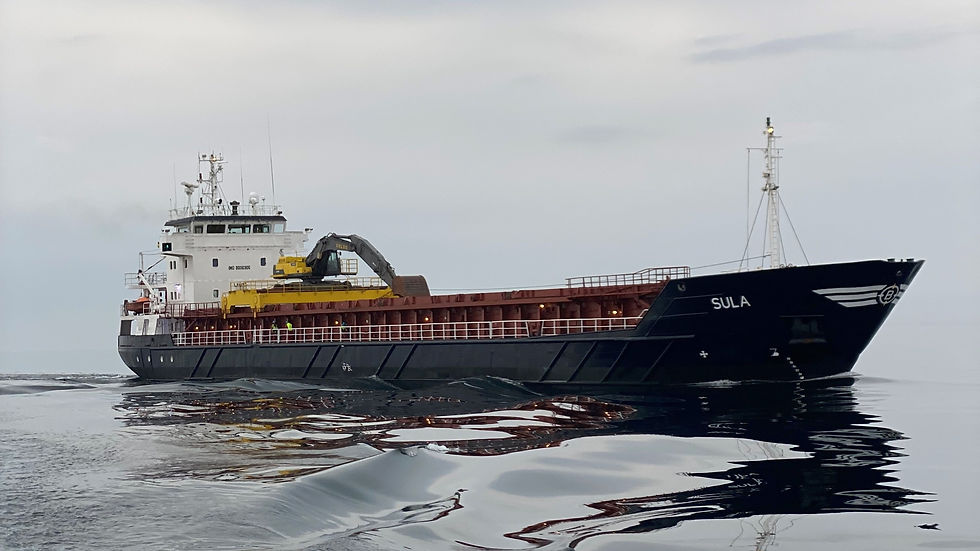
2012
MV Sula
In February 2012, Berge Rederi AS acquired the vessel MV Baltic Sea from Seavoss Schiffahrtskontor GMBH and subsequently renamed her MV Sula. The name Sula is derived from an island in the archipelago outside of Frøya. Within the same year, Sula underwent modifications in Tallinn to become a self-discharging vessel. Boasting a cargo capacity of 3 500 tons, the vessel features a 4 650 cubic meter cargo hold equipped with two movable bulkheads. Sula primarily ships raw materials from Europe for the salmon and agriculture industries in Norway. Outbound shipments typically include dolomite from Hammerfall, crumbles Elnesvågen and split cargo from the west coast of Norway. Although Sula is the smallest vessel in our current fleet, she remains an indispensable asset.

2012
MV Tifjord
Also in February 2012, Berge Rederi AS acquired the vessel MV Molo Sun from Molo Sun AS and subsequently renamed her to MV Tifjord. This transaction included financing facilitated by a local bank in the North West region of Norway. The name Tifjord is derived from an area situated between the islands Ulvøya and Frøya. Historically, the name was also associated with a fishing and cargo vessel owned by Birger Berge, the brother of Øivind and Magne's grandfather. MV Tifjord was already equipped as a self-discharger. The vessel boasted a cargo capacity of 1 700 metric tons, with a 2 795 cubic meter cargo hold that included two movable bulkheads. Her primary cargo consisted of raw materials for the salmon and agriculture industries in Norway. Outbound shipments mainly comprised dolomite and fertilizers, transported in both big bags and bulk. In 2016, Tifjord was chartered out on a bareboat charter party (BBCP) to Vestfrakt Shipping. At the conclusion of this charter party in February 2021, Vestfrakt Shipping AS purchased the vessel.

2013
MV OptiMar
In February 2013, Berge Rederi AS acquired the vessel MV Molo Carrier from Molo Shipping AS and subsequently renamed her MV OptiMar. This marked the third vessel to inherit the name OptiMar. The purchase was facilitated by financing from a local bank in the northwestern region of Norway. Later that same year, OptiMar underwent significant modifications in Tallinn, transforming her into a self-discharger. During this period, she also underwent various repairs during an extended dry dock stay.
The cargo capacity of OptiMar was 2 700 metric tons with a cargo hold volume of 3 800 cubic meters, which featured two movable bulkheads. The primary cargo for the vessel consisted of raw materials for the salmon and agriculture industries in Norway, with outbound shipments mainly comprising dolomite and split stones.
Unfortunately, on 23 December 2017, OptiMar encountered an incident where she grounded on the reef Braken, located off the northwest coast of Norway. The crew was safely evacuated by helicopter and the vessel was later salvaged by the rescue boat Eirk Bye and transported to Kristiansund. After several months, MV OptiMar was declared a total loss and subsequently towed to Stokksund for scrapping. The excavator and other useful parts were transferred to a future aquation, MV Kya.
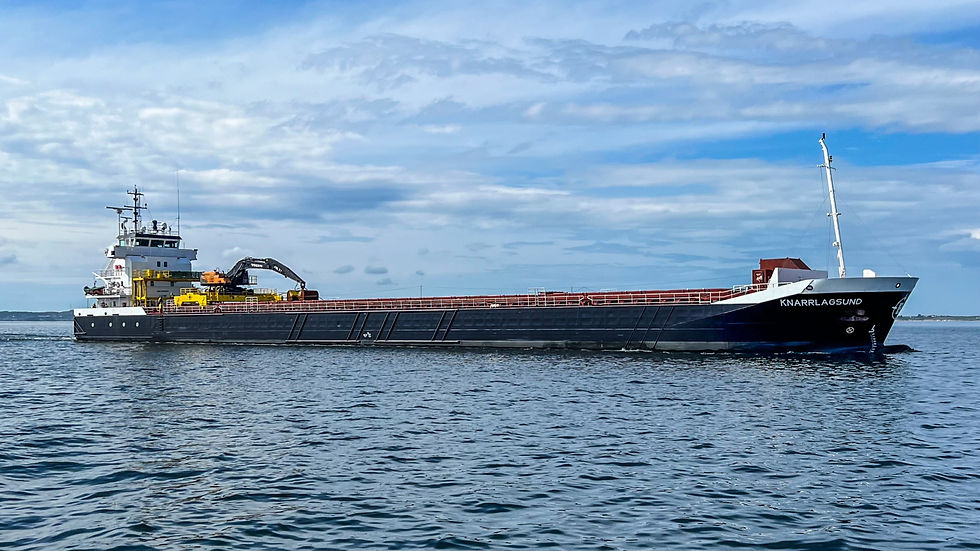
2014
MV Knarrlagsund
In May 2014, Berge Rederi AS acquired the vessel MV Sirocco from Wagenborg and subsequently renamed her MV Knarrlagsund. The name Knarrlagsund is derived from the place where Øivind, Anne Gunn, and Magne Berge currently reside. The same year, the vessel underwent reconstruction in Tallinn to be equipped as a self-discharger.
MV Knarrlagsund boasts a cargo capacity of 5 700 metric tons, with two cargo holds totaling 7 923 cubic meters. These holds are equipped with two movable bulkheads. The vessel primarily ships raw materials for the salmon and agriculture industries in Norway. Outbound cargo includes dolomite, crumbles, timber and split stones.
Occasionally, MV Knarrlagsund undertakes longer voyages, including trips to the Mediterranean during which maintenance is prioritized. Additionally, the vessel is equipped and certified for navigation in Arctic waters, adhering to the Polar Code. Knarrlagsund remains an essential asset of our fleet, standing as the second largest vessel type alongside her sister ship, MV Kya.
The cargo capacity of OptiMar was 2 700 metric tons with a cargo hold volume of 3 800 cubic meters, which featured two movable bulkheads. The primary cargo for the vessel consisted of raw materials for the salmon and agriculture industries in Norway, with outbound shipments mainly comprising dolomite and split stones.
In May 2014, Berge Rederi AS acquired the vessel MV Sirocco from Wagenborg and subsequently renamed her MV Knarrlagsund. The name Knarrlagsund is derived from the place where Øivind, Anne Gunn, and Magne Berge currently reside. The same year, the vessel underwent reconstruction in Tallinn to be equipped as a self-discharger.
MV Knarrlagsund boasts a cargo capacity of 5 700 metric tons, with two cargo holds totaling 7 923 cubic meters. These holds are equipped with two movable bulkheads. The vessel primarily ships raw materials for the salmon and agriculture industries in Norway. Outbound cargo includes dolomite, crumbles, timber and split stones.
Occasionally, MV Knarrlagsund undertakes longer voyages, including trips to the Mediterranean during which maintenance is prioritized. Additionally, the vessel is equipped and certified for navigation in Arctic waters, adhering to the Polar Code. Knarrlagsund remains an essential asset of our fleet, standing as the second largest vessel type alongside her sister ship, MV Kya.

2017
MV Tifjord
In April 2017, Berge Rederi AS acquired the vessel MV Bouga from Atlantico Shipping SL in Spain and subsequently renamed her MV Tifjord, marking her as the second vessel to bear the name Tifjord. The second Tifjord was similar in size to MV Titran and marked the initiation of our practice to name vessels of comparable dimensions with the same initial letter (e.g., T = 4500 - 5000 deadweight tonnes). Later that year, Tifjord underwent reconstruction in Tallinn to be equipped as a self-discharger.
The vessel featured a cargo capacity of 4 750 metric tons and a cargo hold volume of 6 200 cubic meters, comprising two movable bulkheads. The primary cargo consisted of raw materials essential for the salmon and agriculture industries in Norway, with outbound shipments mainly including dolomite, crumbles, and split stones.
In February 2022, Tifjord was sold to a company within the Peak Group and subsequently renamed MV Peak Skorpo.

2018
MV Kjervaagsund
In February 2018, Berge Rederi AS acquired the vessel MV Frieda from Intersee Schiffarths GMBH and subsequently renamed her MV Kjervaagsund. The name Kjervaagsund is derived from a location near Titran on the Island of Frøya. That same year, the vessel underwent modifications in Tallinn, transforming her into a self-discharger.
Kjervaagsund boasts a cargo capacity of 5 600 metric tons with two cargo holds totaling 7 900 cubic meters, featuring two movable bulkheads. The vessel primarily ships raw materials for the salmon and agriculture industries in Norway. Outbound cargoes mainly include dolomite, crumbles, timber and split stones.
Kjervaagsund remains an integral part of our current fleet and a prominent vessel within our operations.

2018
MV Kya
In June 2018, Berge Rederi AS acquired the vessel MV Altena from Wagenborg and subsequently renamed her MV Kya. Kya is the identical sister vessel to MV Knarrlagsund. The name Kya is derived from an island in the archipelago off the coast of Frøya. Later that year, MV Kya was reconstructed in Tallinn to be equipped as a self-discharger.
The vessel features a cargo capacity of 5 700 metric tons with two cargo holds totaling 7 923 cubic meters, which include two movable bulkheads. The primary cargo shipped by MV Kya consists of raw materials for the salmon and agriculture industries in Norway. Outbound shipments mainly include dolomite, crumbles, timber and split stones. MV Kya continues to be a crucial asset in our current fleet.

2019
MV Krabbsund
In May 2019, Berge Rederi AS acquired the vessel MV Ems from HS Schiffarts GMBH, subsequently renaming her to MV Krabbsund. Krabbsund was an exact sister vessel to Knarrlagsund and Kya. The name Krabbsund was derived from a fjord located near Knarrlagsund. In the same year, Krabbsund underwent modifications in Tallinn, converting her into a self-discharger. The vessel had a cargo capacity of 5 700 metric tons, distributed across two cargo holds with a total volume of 7 923 cubic meters which included two movable bulkheads.
The primary cargo shipped by Krabbsund consisted of raw materials for the salmon and agriculture industries in Norway. Outbound shipments mainly included dolomite, crumbles, timber and split stones. The vessel was also equipped and certified in accordance with the Polar Code for navigation in Arctic waters. On the 20th of December 2023, Krabbsund was ultimately sold.

2021
MV Kvitsand
In May 2021, Berge Rederi AS acquired the vessel MV Belterwiede from Capt. Wilhelm H. Van Vee, subsequently renaming her to MV Kvitsand. The name Kvitsand reflects one of its primary cargoes, Dolomite, commonly known as White sand. The following year in Tallinn, the vessel was reconstructed into a self-discharger, despite the ongoing Covid pandemic. With a cargo capacity of 6 350 metric tons, it features two cargo holds totaling 7 950 cubic meters, inclusive of two movable bulkheads. Kvitsand's primary cargo includes raw materials for the salmon and agriculture industries in Norway. Outbound shipments predominantly consist of dolomite, crumbles, timber and split stones. The vessel is also outfitted in accordance with the requirements of the Polar Code certification.
Kvitsand continues to be an integral component of our current fleet.

2021
MV Sletringen
In June 2019, Berge Rederi AS embarked on an ambitious new venture by commissioning the construction of a state of the art vessel from Dayang Shipyard in China. The vessel was named MV Sletringen and was the third vessel to bear the name. She was successfully delivered on December 23, 2021. Following her delivery, Sletringen underwent modifications in Tallinn the subsequent year, transforming her into a highly efficient self-discharger.
The introduction of the third Sletringen represents a significant milestone for Berge Rederi. Not only is she the first newbuilding by the company, but she also marks the company's foray into hybrid technology, utilizing both diesel and electric power sources. This advanced vessel is also equipped with an electric excavator and optimized hull and propeller design to significantly enhance fuel efficiency. This results in remarkably low fuel consumption per loaded tonnage per nautical mile. Additionally, Sletringen boasts minimal CO2 emissions and virtually no NOX emissions, aligning perfectly with our core focus of efficiency, economy and environmental sustainability.
With a substantial cargo capacity of 8 150 metric tons distributed across two cargo holds, the vessel offers an impressive total volume of 12 100 cubic meters including two movable bulkheads. The primary cargo consists of essential raw materials for the salmon and agriculture industries in Norway. Outbound shipments predominantly include dolomite, crumbles, timber and split stones like the rest of the fleet.
The MV Sletringen stands as a testament to our commitment to advancing maritime technology and sustainability. We are proud to have this pioneering vessel as a vital part of our fleet, contributing to our ongoing efforts to enhance operational efficiency and reduce our environmental footprint.

2023
MV Selvaagsund
In March 2021, Berge Rederi AS took another significant step forward by commissioning a second newbuild from Dayang Shipyard. This vessel, named MV Selvaagsund is an identical sister ship to MV Sletringen. With a deadweight tonnage of 8 500, the vessel was delivered June 2023 and modified to a self-discharger the same year in Ijmuiden in the Netherlands.
The vessel is equipped with identical dual power sources as Sletringen, incorporating both diesel and electrical systems. Both sister ships also feature identical electrical excavators. Notably, Selvaagsund is distinguished by a slightly larger propeller compared to Sletringen which significantly enhances fuel efficiency and top speed. Similar to her sister, Selvaagsund boasts very low CO2 emissions and nearly zero NOX emissions, contributing effectively to our net zero focus. The primary cargo of the vessel consists of raw materials for the salmon and agriculture industries in Norway, with outbound shipments predominantly including dolomite, crumbles, timber and split stones. Selvaagsund is a truly exceptional vessel and serves as a cornerstone of our current fleet. Like her sister, her advanced design and capabilities make her an integral part of our operations, ensuring efficiency and sustainability.

2025
MV Sandstad
In December 2022, Berge Rederi AS entered into a third contractual agreement for a newbuilding with Dayang Shipyard. This vessel, to be named MV Sandstad, will be the third of her class joining the ranks of her sister ships, MV Sletringen and MV Selvaagsund. Notably, MV Sandstad will share the same slightly improved hull and propeller design as Selvaagsund, yet it will initially operate without a battery package like her sisters currently possesses. However, she is fully equipped for future installation of the same hybrid system.
The introduction of Sandstad further exemplifies the company's unwavering commitment to operational efficiency and environmental sustainability. We eagerly anticipate Sandstad to our current fleet.
.png)
2026
MV BRF Froan
Berge Rederi AS is revolutionizing the maritime industry with the production of an innovative, emission free vessel to be named BRF Froan. This groundbreaking vessel will be the world's largest battery powered bulk carrier, shipping marble from Brønnøy and Visnes to Omya Hustadmarmor's production plant in Elnesvågen. The vessel will be equipped with a heavily advanced battery system of 23,5 mWh and feature two rotor sails aft to further enhance energy efficiency.
BRF Froan will cover approximately 230 nautical miles per voyage, setting a new industry benchmark far beyond the current longest battery electric ferry route of 15 nautical miles. She is expected to significantly reduce environmental impact, cutting CO2 emissions by about 9 000 tons and NOx emissions by 200 tons annually. This will be supported by shore power infrastructure at both ports.
The project is backed by the Norwegian NOx Fund and Enova, with guidance from the GSP Service Centre for Green Fleet Renewal. By integrating advanced technologies, this vessel will set a remarkable precedent for large scale, zero emission maritime operations.
bottom of page
